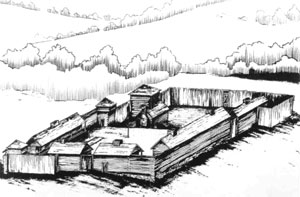
Tellico Blockhouse
This Monroe County historic site was a key federal outpost on the southwest frontier constructed in 1794-95 at the confluence of the Tellico and Little Tennessee Rivers adjacent to the site of the earlier Fort Loudoun. For protection from aggressive settlers, the dwindling number of Overhill Cherokees in the Little Tennessee River country sought to reestablish an alliance with the newly created federal government. Federal officials in Philadelphia were also interested in a Cherokee alliance and envisioned that a series of frontier posts would help to control and “civilize” the Native Americans. In 1794 Territorial Governor William Blount agreed to a request from Hanging Maw to build a new federal post, which would eventually serve as a military fort and trading post. At Tellico Blockhouse, federal and territorial officials implemented the Factory Act of 1795, which was a Washington administration plan to assimilate the Indians by maintaining federal “factories,” or trading posts, where Indians would receive fair exchange for their furs as well as learn farming and mechanical skills.
Implementation of the Factory Act in 1795-96 required close and at least open relations between the soldiers, traders, and the Cherokees. John McKee was the first Indian agent at Tellico; a later agent, Silas Dinsmoor, provided cotton cards, spinning wheels, looms, and cottonseed in the hope of teaching the Cherokees how to spin and produce their own cloth. In return for the trade goods and training, the Cherokees provided food, furs, and other valuable items. The Duke of Orleans (later King Louis Philippe of France) visited the post in 1799 and observed that the Cherokees “continually supply Tellico with game, eggs, fruits in season, etc. so that the Tellico market is always well stocked, and is certainly one of the best forts in the region. The availability of women makes it very pleasant for the soldiers. Just now there is an abundance of strawberries, which the women and girls bring in and sell at ninepence the gallon.” (1)
In 1805 federal officials and the Overhill Cherokees negotiated a new land cession and treaty at Tellico Blockhouse. This agreement moved the federal agency south to the mouth of the Hiwassee River. In 1807 the federal government abandoned Tellico and moved its remaining operations to the Hiwassee River post, which was the new center of the Overhill Cherokee settlements.
Today the site of Tellico Blockhouse is part of the Fort Loudoun State Historical Area. The archaeological remains of the post are intact and partially exposed to indicate the size of the fort and the range of activities that took place there.



